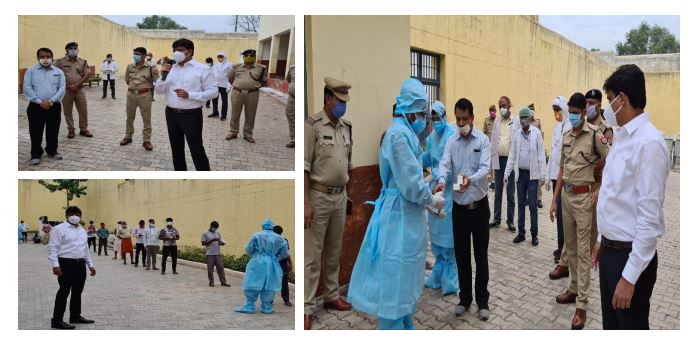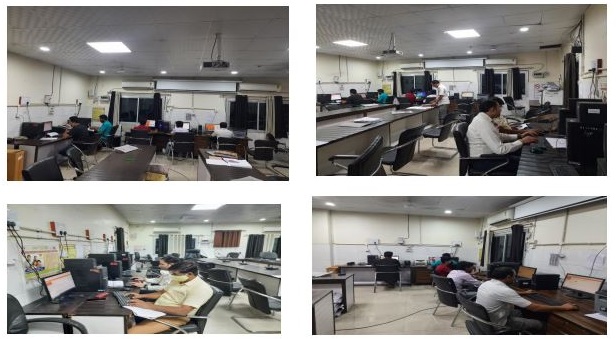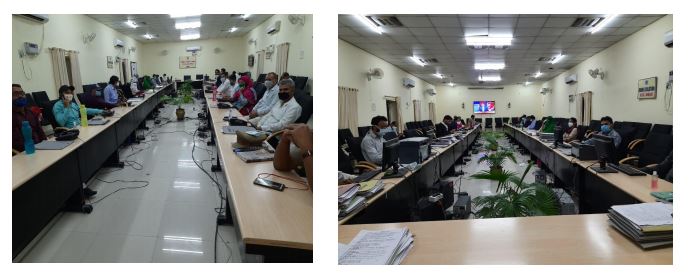
 The year 2020 is one the most dreadful year of the decade with the COVID-19 pandemic claiming millions of lives across the globe. As the decade comes to an end, the governments globally are working on overcoming the challenges raised by the pandemic and safeguarding humanity. Similar is the case with Jhansi District Administration led by Andra Vamsi, Collector and District Magistrate, Jhansi, as they implement their action plan to deal with the pandemic, writes Adarsh Som of Elets News Network (ENN).
The year 2020 is one the most dreadful year of the decade with the COVID-19 pandemic claiming millions of lives across the globe. As the decade comes to an end, the governments globally are working on overcoming the challenges raised by the pandemic and safeguarding humanity. Similar is the case with Jhansi District Administration led by Andra Vamsi, Collector and District Magistrate, Jhansi, as they implement their action plan to deal with the pandemic, writes Adarsh Som of Elets News Network (ENN).
Since its onset, the COVID pandemic has shaken the world with its deadly impact on humanity. The pandemic has been viewed as a disastrous situation due to its highly contagious nature which has seen millions succumbed to the viral infection in a mere year. However, India’s response to the pandemic in the form of a countrywide complete lockdown was well appreciated worldwide. These efforts gave somewhat desired results due to the effective implementation of strategies at the grassroots level or the district level and Jhansi is one among these districts.
Preventing COVID Spread

Jhansi, a district in the state of Uttar Pradesh, has been proactively taking controlling measures to duel with the COVID pandemic. The roadmap strategy adopted by Jhansi admnistration to curb the menace is strict adherence to the guidelines issued by the Government of India and ensuring that lockdown with social distancing is observed at its best. To achieve this, “The district administration shunned all the non-essential movement across the district and allowed only the movement to supply essential goods including food, water, medicines, groceries, dry ration, etc. Moreover, to ensure no movement at the borders, the district administration placed barriers at 42 points and manned these by a team consisting of a magistrate, a doctor, police squad of sub-inspectors, and two constables”, said the DM in an interview with Elets News Network.
Besides keeping a strict check on the movement of people and social distancing, Jhansi also strategised the movement of essential commodities from source to consumer. Hence, the people of Jhansi were delivered the essentials to meet their everyday requirements at their doorstep. In addition, the administration ensured food for all to reduce affliction among the poor and the needy. “For this, Jhansi administration in association with NGOs opened up as many as 22 community kitchens across the district”, told Andra Vamsi.

Healthcare Facilities
It was not the preventive measures that Jhansi focussed on but also the availability of proper healthcare, medicines, quarantine centres, isolation wards, medical staff, and other associated facilities. To ensure that people affected receive proper treatment and care, the Jhansiadmnstration opened L-1, L-2 and L-3 hospitals or dedicated COVID Healthcare Centres (CHCs).
Also Read: Jhansi all geared to handle COVID-19 outbreak: Andra Vamsi
L-1 hospitals were referred for patients clinically assigned as ‘positive’ but asymptomatic. Badagaon, Baruasagar, Ranipur, Garautha, Paramedical College (Blocks 3 & 4), Bhagwan Mahavir Arogya Bharti Hospital, Jhansi Cantt General Hospital, Pt Deen Dayal Shelter Home were the made CHCs or L-1 Hospitals. The District Jail, Jhansi had also made functional one of its barracks as L-1 facility for isolation of its ‘positive’ inmates. Considering private hospitals in the list, St Jude Hospital and Hi-Tech Hospital were also turned into L-1 facilities. Besides this, nine private hotels have been designated as L-1 facilities. All the L-1 Hospitals have a combined capacity of about 1400 beds.
Patients who develop any moderate to severe symptoms were duly referred to higher L-2/ L-3 facilities as per the medical officer’s assessment.
Railway Hospital, Jhansi, has been upgraded as L-2 category Covid Health Centre. It is a 100-bed hospital having 22 ICUs and 78 isolation beds with 12 ventilators of which eight are invasive and four are non-invasive. It also has a lab facility connected with the Non-Covid Railway Hospital. To ensure proper support to the patients with serious symptoms, sufficient availability of oxygen with 140 B-type cylinders and 10 D-type (jumbo) cylinders are made available. A dedicated team with six medical officers, three anaesthetics, nine staff nurses, six ward boys and nine sweepers are working round the clock. Apart from above, two private hospitals (Hi-Tech- 15 beds and St. Judes-22 beds) were operating about 37-bed capacity L-2 facilities with full equipment and personnel support.
Considering the status of L-3 hospitals, 230 (120 ICUs and 110 Isolation beds) has been made available at a State of the Art Covid-19 Hospital with 24×7 facility of COVID dedicated Digital X-ray, Ultrasound, X-ray, CT-scan & Pathology services. The hospital is equipped with over 115 ventilators (Bell-44, AGVAD-11 and MAACQUET24), HFNC-52, Bi-Paps-10, Humidifier-01. Moreover, the hospital features COVID-19 Operation Theatres, Dialysis & Labour room. The hospital caters to over 25 lakhs population of Jhansi and the nearby districts. It also the first centre to start voluntary testing of COVID-19 through a helpdesk.
Further, Jhansi administration has set up a BSL-3 COVID Testing Laboratory at the Department of Microbiology, MLB Medical College that commenced operations on April 8, 2020. The lab is equipped with a BSL-3 facility, RNA extraction machines, PCR machines, and TrueNAT machines. As on November 1, 2020, the lab had completed 3.50 lakh tests that include more than 80,000 RT-PCR tests of people from Jhansi district alone. The lab caters not only to Jhansi but also to Mahoba and Lalitpur districts. Earlier, when it was a stand-alone lab for Bundelkhand region, it catered to Jalaun and Banda districts as well.
Plasma Therapy: A Remedy
Jhansi administration, when figured that Plasma Therapy can be a boon to treat COVID infected patients, the authorities started providing the therapy. The district authorities adopted the Indian Council of Medical Research (ICMR) approved convalescent Plasma Therapy. For this, the Apheresis machine was procured from Parakh Blood Bank. The blood bank also helped in providing the plasma from voluntary donors free of cost. This model of collaborating with the nearby blood bank was well appreciated and saved a significant amount of money and efforts as the donor used to go to Kanpur Medical College or KGMU Lucknow for getting Plasma and depositing it back in MLB Medical College Plasma Bank.
Also Read: Smart Grievance Redressal in Uttar Pradesh : Andra Vamsi
Database Management
As Jhansi developed facilities to provide apt healthcare to the patients, it also went a step further and established a Database Management System at the Chief Medical Officer’s (CMO) Office. For the cause, the strict administration established a Separate Call Centre at CMO Office and hired a total of 23 operators who have been posted shift wise for daily activities.
The allocation to CHCs is done through CMO Office for all the positive cases and regular follow-up is done until the patients turn negative. Records of all tested cases are fed to the portal and follow-up is done through voice calling for seven days.
Integrated Command and Control Centre in Jhansi
As soon as the nationwide lockdown was declared by Prime Minister, the District Control Room which, in routine, is used for IGRS was converted into District COVID-19 control room. Apart from this, separate stand-alone Control Rooms were working in the CMO Office, Nagar Nigam, Jal Sansthan and DSO Office. However, since all the departments sat separately in different places and communicated separately, there was a lack of coordination. Hence, integration became a must for efficient and effective operation.
Therefore, overnight, the CMO control Room along with Telephone number was shifted to District Control Room in Collectorate campus. Initially, only the district administration, police and health department had representation in the Control Room so efforts directions were given to expand this to other departments. Hence, representatives from Police- Sub Inspector, Nagar Nigam- Sanitation Inspector, Supply Department- Supply Inspector, Water Supply Departments also began sitting in the Integrated Control Room for rapid redressal of complaints.
 The Integrated Covid Command and Control Centre (ICCC) was established at Gandhi Sabhaghar, Collectorate Campus Jhansi with the objective to serve as a one-stop centre for all COVID-related services and grievance redressal.
The Integrated Covid Command and Control Centre (ICCC) was established at Gandhi Sabhaghar, Collectorate Campus Jhansi with the objective to serve as a one-stop centre for all COVID-related services and grievance redressal.
A total of six nodal officers, six doctors, 27 RRTs/health workers, 30 computer operators, two police officers, three rural and three urban development workers were appointed for round the clock service at the ICCC. A total of 2034 calls have been received yet and 1980 of these have been resolved. Calls are being made to active patients who are in home isolation twice a day.
A set of specific tasks were allocated to the personnel deputed at the ICCC. These include:
-
Redressing complaints received on CM helpline and lockdown dashboard.
-
Sending reports to the state government at stipulated time.
-
Receiving complaints, routing it to the appropriate level for redressal and taking feedback from the caller to ask for satisfaction.
-
Through food cell, ensuring food for all.
-
On receiving complaints regarding COVID-19 suspect, urgently taking appropriate action.
-
Collating Information from various departments and levels regarding the COVID-19 crisis.
-
To attend the hotline video conferencing of relief commissioner.
Furthermore, 27 Rapid Response Teams (RRTs) are working at the ICCC. The Main Purpose of these teams is to verify the eligibility of patients for home isolation. Jhansi district has 26 ambulances of 108 service, 24 ambulances of 102 service and four ambulances of ALS Service in which all ambulances are operational. The response time of 108, 102 and ALS ambulances are 16: 26 minutes, 17: 13 minutes and 15: 13 minutes respectively, as per the data from the district administration.
The proactive nature of Jhansi administration, their strategic planning, effective execution and adoption of technological aids posed a gamechanger in tackling the COVID-19 pandemic. The district is effectively managing to reduce the impact of the pandemic and safeguard the people and the year 2020 bears witness to it.
Be a part of Elets Collaborative Initiatives. Join Us for Upcoming Events and explore business opportunities. Like us on Facebook , connect with us on LinkedIn and follow us on Twitter, Instagram.











